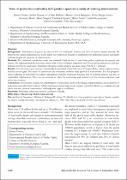| dc.contributor.author | Osuret, Jimmy | |
| dc.contributor.author | Namatovu, Stellah | |
| dc.contributor.author | Biribawa, Claire | |
| dc.contributor.author | Balugaba, Bonny E | |
| dc.contributor.author | Zziwa, Esther Bayiga | |
| dc.contributor.author | Muni, Kennedy | |
| dc.contributor.author | Ningwa, Albert | |
| dc.contributor.author | Oporia, Fredrick | |
| dc.contributor.author | Mutto, Milton | |
| dc.contributor.author | Kyamanywa, Patrick | |
| dc.contributor.author | Guwatudde, David | |
| dc.contributor.author | Kobusingye, Olive | |
| dc.date.accessioned | 2022-04-27T13:59:02Z | |
| dc.date.available | 2022-04-27T13:59:02Z | |
| dc.date.issued | 2021 | |
| dc.identifier.citation | Osuret, J., Namatovu, S., Biribawa, C., Balugaba, B.E., Zziwa, E.B., Muni, K., Ningwa, A., Oporia, F., Mutto, M., Kyamanywa, P. and Guwatudde, D. (2021). State of pedestrian road safety in Uganda: a qualitative study of existing interventions. African Health Sciences, 21(3), pp.1498-1506. | en_US |
| dc.identifier.issn | 1680-6905 / 1729-0503 | |
| dc.identifier.uri | http://hdl.handle.net/20.500.12280/2980 | |
| dc.description.abstract | Background: Pedestrians in Uganda account for 40% of road traffic fatalities and 25% of serious injuries annually. We explored the current pedestrian road traffic injury interventions in Uganda to understand why pedestrian injuries and deaths continue despite the presence of interventions.
Methods: We conducted a qualitative study that involved a desk review of road safety policy, regulatory documents, and reports. We supplemented the document review with 14 key informant interviews and 4 focus group discussions with par- ticipants involved in road safety. Qualitative thematic content analysis was done using ATLAS. ti 7 software.
Results: Five thematic topics emerged. Specifically, Uganda had a Non-Motorized Transport Policy whose implementation revealed several gaps. The needs of pedestrians and contextual evidence were ignored in road systems. The key program- matic challenges in pedestrian road safety management included inadequate funding, lack of political support, and lack of stakeholder collaboration. There was no evidence of plans for monitoring and evaluation of the various pedestrian road safety interventions.
Conclusion: The research revealed low prioritization of pedestrian needs in the design, implementation, and evaluation of pedestrian road safety interventions. Addressing Uganda’s pedestrian needs requires concerted efforts to coordinate all road safety activities, political commitment, and budgetary support at all levels. | en_US |
| dc.language.iso | en | en_US |
| dc.publisher | Makerere Univ, Coll Health Sciences,Sch Med , Po Box 7072, Kampala, Uganda, 00000 | en_US |
| dc.relation.ispartofseries | African Health Sciences;21(3) | |
| dc.subject | Pedestrian | en_US |
| dc.subject | Safety intervention | en_US |
| dc.subject | Qualitative | en_US |
| dc.subject | Uganda | en_US |
| dc.title | State of Pedestrian Road Safety in Uganda: A Qualitative Study of Existing Interventions | en_US |
| dc.type | Article | en_US |


